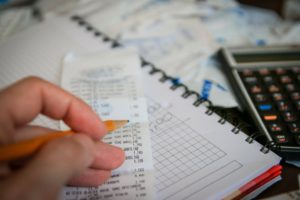Blog
Posted July 16, 2020
How much money should I put aside for my Personal Tax Bill?
Estimating how much you need to save for your end of year tax bill can be tough, especially if your business has quite a few expenses.
If your freelance business provides a service like tutoring or marketing, you may have limited expenses and you will take home a large part of what you turnover.
However, if you are running a shop or a business such as a builder that buys a lot of materials, it will be more difficult to estimate how much you need to save as your income will be substantially less than your turnover.
Being self-employed comes with a whole load of tax responsibilities and with these you will need to budget for the tax that you will owe HMRC at the end of the year.
It can be a challenge calculating how much you might owe HMRC as the year goes along especially if you are running a start-up business or growing rapidly.
In this blog we will consider some things you might want to keep in mind and some tactics you might want to apply in budgeting for your tax.
Saving for your personal tax bill as a self-employed individual
The percentage of your income that you need to save for taxes depends on how much you are earning. The UK the tax system is a progressive tax system which means the more you earn the higher the tax rate, and the more tax you pay. As an individual the tax rates vary from 0% to 45% depending on the type and amount of income.
Calculating what percentage to save for your personal tax bill
As a general rule of thumb you should look to save between 20% and 35% of your income. As shown in the calculations below, this should cover the majority of your tax bill (the calculations below assume the tax payer is resident in England).
| Income £20,000 | Income £50,000 | Income £75,000 | |
| Income | 20,000 | 50,000 | 75,000 |
| Less Personal Tax Allowance | (12,500) | (12,500) | (12,500) |
| 7,500 | 37,500 | 62,500 | |
| Income Tax | |||
| Tax @ 20% | 1,500 | 7,500 | 7,500 |
| Tax @ 40% | 0 | 0 | 10,000 |
| National Insurance | |||
| Class 2 | 159 | 159 | 159 |
| Class 4 | 945 | 3,645 | 4,155 |
| Total Tax/NI | 2,604 | 11,304 | 21,804 |
| Tax as a % of income | 13.0% | 22.6% | 29.1% |
Payments on Account
If you are in your first year of trade, you will need to ensure that you save enough tax to cover any payment on account that will be due towards subsequent tax years. If you aren’t sure whether the payment on account system applies to you, check out our previous blog on what a payment on account is and how it is calculated https://whitesidesca.com/what-is-a-payment-on-account-and-do-i-need-to-pay-it/.
Save a Small Amount Every Month
One of the easiest ways to pay your tax bill is to set aside money every month into a separate bank account so that you build up a pot to cover the tax at the end of the year. You are essentially operating your own pay as you earn scheme by saving the tax due on that income. By saving as you go along it means that you won’t have any nasty surprises at the end of the year.
If you are unsure on how much tax you should be saving, give your accountant a call and they should be able to estimate it for you.
Image by Michal Jarmoluk from Pixabay
SERVICES
LATEST NEWS
CATEGORIES
- Blog (137)
- Business Advice (45)
- Just For Fun (16)
- Tax Tips (30)
- Video (8)











